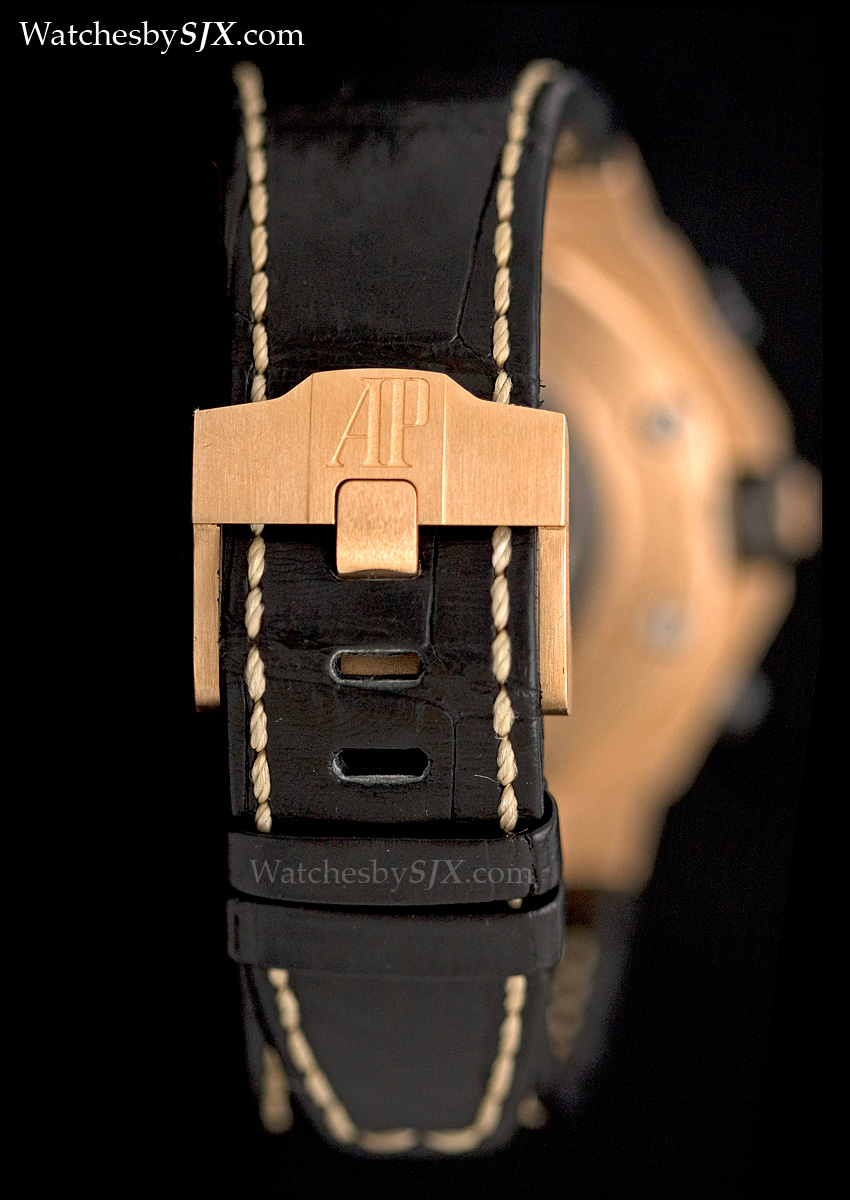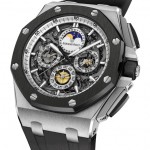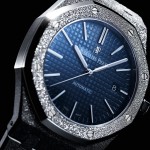A Hands-On, In-Depth Guide to the New Audemars Piguet Royal Oak Offshore 42 mm Ref. 26470 (with live photos and price)
Presented at SIHH 2014, the new Royal Oak Offshore Ref. 26470 is the first major and complete revamp of the classic 42 mm Offshore since its introduction. Audemars Piguet kept all the key elements of the watch, but made several vital improvements, leaving it much the same, but better.
Audemars Piguet launched the Royal Oak Offshore in 1993 as a larger, sportier version of its classic Royal Oak. It took a while for the Offshore to catch on, but eventually it became one of the horological status symbols of the last decade. Though the Offshore multiplied into dozens upon dozens of variations in recent years, the basic 42 mm Offshore remained fundamentally the same. And so it was high time for a revamp, which happened at SIHH 2014 with the new Royal Oak Offshore 42 mm Ref. 26470, a tangibly better watch than its predecessor.
To start with, the new collection comprises just six models – two in pink gold and four in steel – which will eventually replace all the first generation Offshores. The overall look and feel remains the same. Both the brushed and polished surfaces of the case are exemplary in their finishing. Compared to the obvious competition like Hublot and Patek Philippe, the Offshore is still superior in its case finish.
.jpg)
.jpg)
.jpg)
Though the new 42 mm Offshore looks much the same, several important features have changed. The crown and pusher guards are now larger and more angular, with a similar profile to those found in the Offshore 44 mm.
.jpg)
More importantly, the crown and pushers are in black ceramic, while previously they were coated in synthetic rubber. These have a brushed finish and sharply defined edges that few other manufacturers are able to accomplish with ceramic.
.jpg)
.jpg)
The dials are still decorated with the grand tapisserie chequerboard guilloche synonymous with the Royal Oak. But they now have the broader hands found in the larger Offshore models. While the Arabic numerals were found on earlier Offshores, the numbers now have a similar and more angular font. Also, the date disc is now matched with either the colour of the dial or numerals.
.jpg)
.jpg)
.jpg)
The most important upgrade is the movement. From the very beginning the Offshore used a Jaeger-LeCoultre calibre 889 with a Dubois-Depraz chronograph module on the top. Though the JLC was a finely constructed movement, it was long in tooth and was finished in an appealing but workmanlike manner.
While this was acceptable in the early days, it became increasingly down-market compared to the competition, which was going in-house. At the same time the price of the Offshore keep on rising, making it amongst the most expensive watches in its segment of the luxury sports chronograph.
.jpg)
Though AP gave certain pricier editions an in-house base movement, the basic Offshore models still stuck with the JLC movement. Fortunately that is no longer the case. The new Offshore the whole line will be powered by the calibre 3126, a well conceived decorated automatic movement.
This is visible through the display back, which eliminates the soft-iron cage. That provided additional protection against magnetism; the current Offshore has magnetism resistance in excess of the minimum 4800 A/m specified by the ISO for an anti-magnetic watch. Though the first generation had higher magnetism resistance, from a practical point of view this is unimportant since exposure to magnetism in daily life is trivial.
.jpg)
Made in-house by AP, the calibre 3126 has a large, adjustable mass balance wheel and a full balance bridge – two features that contribute to stable timekeeping. It has a single barrel and a longish 60 hour power reserve, plus a useful safety mechanism on the date that prevents it from being changed manually around midnight, which can cause damage.
A distinctive characteristic is the rotor decorated with the Audemars and Piguet family crests which spans about 100 degrees, instead of the 180 degree half circle of most rotors. Despite being smaller, the rotor is thick and made of 22k gold, giving it enough mass to wind efficiently.
.jpg)
The movement is attractively decorated with the fine touches expected of a high-end movement. In particular, the polished countersinks for the jewels and screws are beautifully polished and practically glow.
.jpg)
.jpg)
.jpg)
One element characteristic of AP is the diamond-cut bevelling on the edges of the bridges, which results in line that seems razor sharp. However, some of these bevels are not hand-polished after they are cut, leaving minute traces of machining visible under magnification.
.jpg)
.jpg)
Well made as the base movement is, the chronograph is still modular, with the same Dubois-Depraz chronograph module. Though functionally no different from an integrated chronograph, it is less appealing visually since no chronograph mechanism is visible from the back, and also a less sophisticated construction. AP has made noises about finally producing an in-house chronograph movement, but for now this will have to do.
And the new Offshore is sold with a pin buckle as standard, replacing the thin deployant clasp of before that was ill-suited to such a chunky watch. The pin buckle not only looks better, it also sits better on the wrist.
.jpg)
.jpg)
The new line comprises two models in pink gold with a pink gold dial, with the only difference being the gold bracelet or crocodile strap.
.jpg)
.jpg)

The version on a pink gold bracelet is lavishly ostentatious, the sort of watch which a select few can wear on all the time, and most others only on select occasions.
.jpg)
.jpg)
The steel version has six different guises. The “Navy” Offshore in blue and orange on a rubber strap, making it the freshest and most casual of the line-up.
.jpg)
.jpg)
Also in a brown and ivory “Safari”, which has a slightly Italian-vintage-patina feel in its colours.
.jpg)
.jpg)
And also more conventional colours, in red and black, and very subdued grey and black.
.jpg)
.jpg)
.jpg)
.jpg)
The price of the new Offshore in US dollars is as follows: $25,600 in steel with rubber strap $26,000 in steel with hornback crocodile strap $40,700 in pink gold with hornback crocodile strap $69,200 in pink gold with pink gold bracelet They will be available from the second quarter of 2014.
.jpg)
.jpg)
.jpg)
.jpg)
.jpg)
.jpg)
.jpg)
.jpg)
.jpg)
.jpg)
.jpg)








